Robots are awesome in theory but hilariously terrible in reality. You might think they’re sci-fi heroes, but they can’t handle basic tasks like walking on uneven ground or avoiding obstacles. Why? Their sensors go haywire, batteries die fast, and they’re confused by shadows and unexpected movements. Machine learning helps, but they’re still basically toddlers trying to navigate a complex world. Curious about their epic fails?
The Economic Toll of Robotic Automation
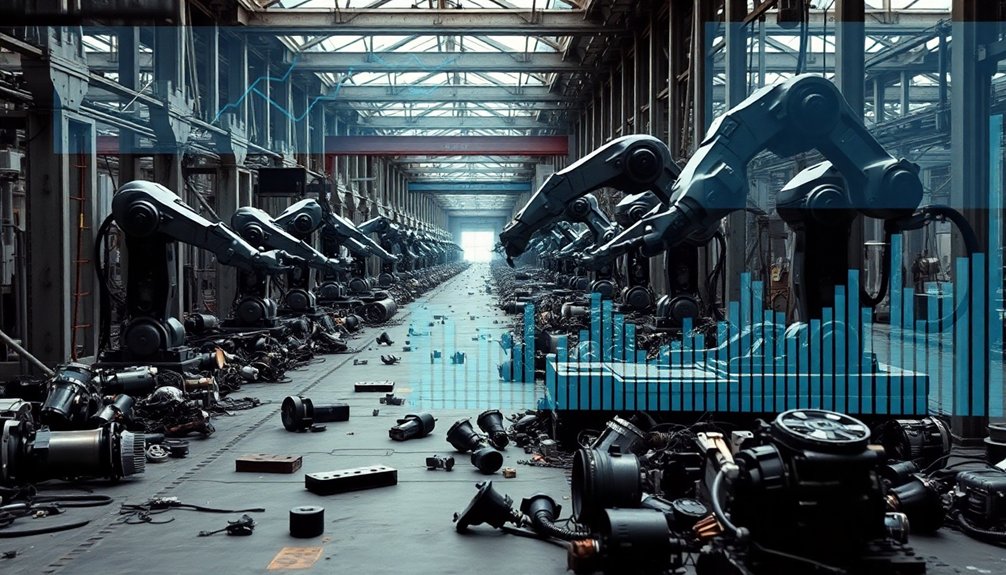
While robots might sound like sci-fi fantasy, they’re rapidly transforming our economic landscape—and not everyone’s thrilled about the revolution. Your job might vanish faster than you think, replaced by a machine that works 24/7 without coffee breaks.
Robotic revolution: Jobs disappearing, machines rising, human workers facing an unforgiving technological tsunami.
Automation’s hitting industries hard: manufacturing, logistics, and service sectors are shedding human workers like last season’s fashion. Workforce displacement is particularly severe, with one robot potentially eliminating 400,000 jobs per 1,000 workers.
Those fancy robotic systems are costing companies millions, but they’re betting big on long-term savings. The catch? Skilled workers are getting left behind, creating a brutal economic divide. Countries like China and South Korea are leading the global robotics adoption, accelerating the technological transformation at an unprecedented pace.
Some regions will dominate global supply chains, while others watch helplessly. Your industry could be next—will you adapt or become another statistic in the robotic workforce takeover? Companies are increasingly turning to Robot-as-a-Service models to reduce initial investment costs and mitigate economic risks of automation.
Technical Hurdles in Autonomous Navigation
If you’ve ever watched a robot bumble around a room like a drunk uncle at a wedding, you’ll understand why autonomous navigation isn’t just a tech challenge—it’s a comedy of errors. Sensor fusion techniques help robots combine multiple data inputs to better understand their environment, reducing the likelihood of navigational mishaps. These mechanical wanderers struggle with basic tasks that humans do without thinking. Imagine a robot paralyzed by a shiny floor or mistaking a package for a person—welcome to the wild world of robotic perception. Machine learning algorithms continuously improve robots’ ability to adapt and learn from navigation challenges, making each mistake a potential learning opportunity. Tight spaces become obstacle courses, sensors get overwhelmed, and algorithms freeze faster than your laptop during a video call. Precision motion control demands that robots navigate intricate environments with minimal margin for error, making every movement a calculated risk. They’re trying to process complex environments in real-time, juggling sensor data, avoiding collisions, and not looking like complete idiots. It’s like teaching a toddler to navigate rush hour—challenging, unpredictable, and occasionally hilarious.
Environmental Challenges for Robotic Performance
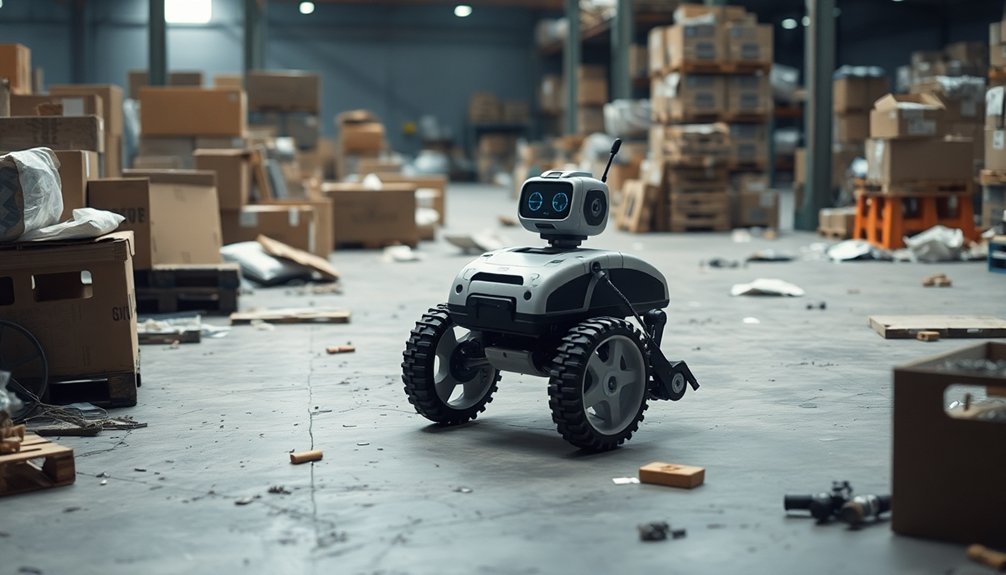
You’ve heard robots are supposed to be the future, but they’re basically overgrown toddlers when it comes to handling real-world terrain—stumbling over rocks, freezing in unexpected weather, and looking confused when things don’t match their preprogrammed expectations. Energy consumption significantly impacts a robot’s real-world performance, with operational efficiency determining whether these machines can sustainably operate outside controlled environments. Thermal management strategies play a critical role in helping robots adapt to challenging environmental conditions.
Climate and landscape throw serious curveballs at these high-tech machines, revealing just how fragile our supposedly advanced robotic systems can be when they’re not in a perfectly controlled lab environment. Rare earth materials significantly complicate robotic design, adding another layer of environmental complexity to their outdoor performance challenges.
Deploying robots outdoors isn’t just about cool tech; it’s a complex chess match of engineering, adaptation, and proving whether these mechanical marvels can actually survive beyond their cushy computational comfort zones.
Terrain Navigation Difficulties
Because robots aren’t hiking buddies with built-in mountain goat instincts, traversing real-world terrain remains a nightmare of technical complexity. Adaptive sensing techniques like Multimodal Coupling help robots parse complex environmental information through integrated exteroceptive and proprioceptive strategies. Cameras struggle with shadows, grass that blocks sensors, weird lighting that turns cameras blind. Think of terrain like a giant puzzle where every piece changes shape and mood. Cameras struggle with shadows, LiDAR gets tangled in vegetation, and proprioceptive sensors throw constant temper tantrums when surfaces get uneven. Quadrupedal robots have an edge, but they’re still basically learning to walk like toddlers in a world of unexpected bumps and sudden drops. Neuromorphic computing can help robots process sensory inputs more rapidly, potentially improving their ability to adapt to complex terrain challenges. How do you teach a machine to understand ground that’s constantly transforming? That’s the multi-million dollar question keeping robotics engineers awake at night.
Climate Impact Performance
Robots aren’t just technological marvels—they’re also environmental headaches waiting to happen. You might think these high-tech helpers are saving the world, but they’re secretly guzzling energy like gas-guzzling monsters.
Most industrial robots run on fossil fuels, pumping out carbon emissions faster than you can say “green technology.” And let’s talk rare earth materials—those precious elements aren’t just expensive, they’re environmental nightmares, leaving toxic scars across mining landscapes.
But here’s a glimmer of hope: renewable energy and smarter designs could slash CO₂ emissions by 80%. Robotic restoration technologies like DroneSeed demonstrate ecosystem regeneration potential by efficiently planting trees and mapping environmental restoration strategies. Electromechanical actuators are becoming more energy-efficient, potentially reducing the overall carbon footprint of robotic systems.
Imagine robots powered by solar panels, running on recycled materials, consuming energy like a hybrid car instead of a tank. The future’s not about eliminating robots, it’s about making them work smarter, not harder—for our planet. Small swarm robots can actually help reduce environmental impact by minimizing soil disturbance during ecological monitoring and restoration efforts.
Infrastructure Deployment Barriers
When urban landscapes turn into robotic obstacle courses, dreams of seamless technological integration quickly crash into reality. Your high-tech robot isn’t just fighting algorithms; it’s battling physical chaos. Sidewalk infrastructure challenges can transform delivery robots into struggling navigational nightmares, as seen in pilot projects where uneven urban terrain repeatedly defeated autonomous mobility. Sensor fusion technologies attempt to mitigate these challenges by integrating multiple data sources for more comprehensive environmental perception.
Infrastructure deployment becomes a nightmare when sensors can’t handle real-world complexity.
Robots face epic challenges like:
- Dodging broken sidewalks that resemble lunar landscapes
- Traversing narrow pathways crowded with unexpected barriers
- Surviving sensor-blinding dust and debris environments
- Overcoming communication dead zones that interrupt critical operations
Think your robot’s gonna smoothly cruise city streets? Think again.
Between uneven terrain, wireless interference, and urban clutter, these machines are more like awkward tourists than conquering technological pioneers. They’re constantly struggling to interpret environments that humans maneuver effortlessly, turning each deployment into an unpredictable adventure of technological trial and error.
Data Management and Processing Complexities
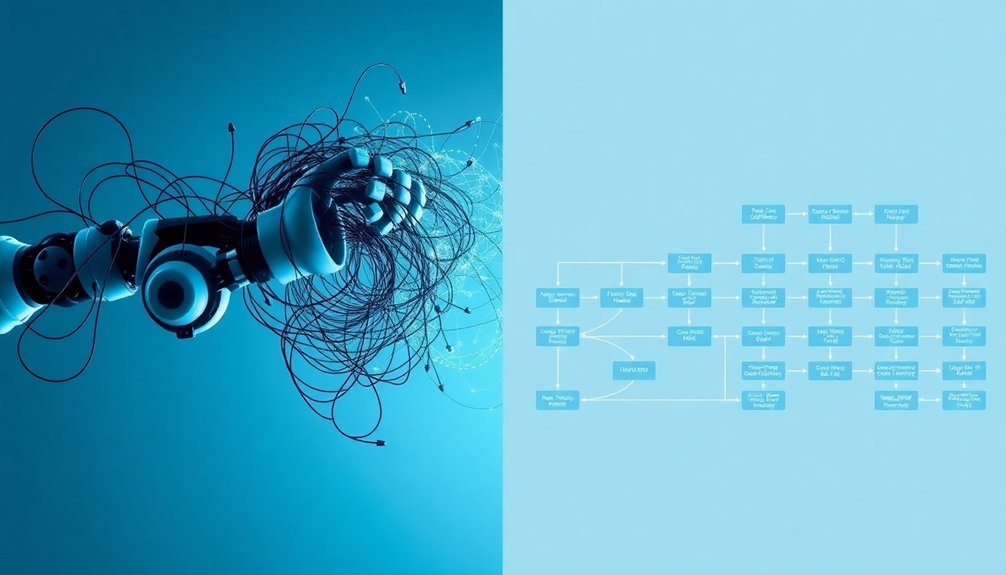
You’ve got robots rolling around collecting data like digital hoarders, but the sheer volume of sensor information is threatening to crash their tiny silicon brains. Convolutional Neural Networks rapidly process complex sensor data, transforming chaotic point clouds into navigable terrain through advanced AI algorithms. The problem isn’t just that they’re collecting too much—it’s that processing all those LiDAR scans, camera feeds, and movement logs is like trying to drink from a fire hose of raw information. And if that wasn’t tricky enough, every transmission risks exposing sensitive spatial data, turning your innocent autonomous vehicle into a potential privacy nightmare.
Data Volume Overwhelms Systems
As the digital universe expands like an overstuffed closet, current robotic systems are drowning in a tsunami of data they can’t effectively manage or process.
You’re witnessing technological systems crumbling under massive information loads, struggling to make sense of cascading data streams.
Why do robots choke on data? Consider these critical bottlenecks:
- Exponential growth outpaces computational capacity
- Heterogeneous data sources create integration nightmares
- Processing requirements balloon beyond realistic thresholds
- Real-time adaptation becomes virtually impossible
Imagine trying to drink water from a fire hose—that’s fundamentally what these systems attempt when handling massive datasets.
The result? Overwhelmed circuits, fragmented insights, and robotics that look impressive on paper but fall apart in practical applications.
Your smart machine isn’t so smart when it’s gasping under an information deluge. Neuromorphic computing offers a potential breakthrough by enhancing machine learning efficiency and reducing power consumption while improving data processing capabilities.
Algorithmic Processing Limitations
Data overwhelm meets its algorithmic match in the complex world of robotic processing.
You’ve seen the promise: smart bots zipping through tasks. But here’s the catch—algorithms aren’t mind readers. They crumble when faced with nuanced scenarios that require genuine understanding.
Creative problem-solving? Not their strong suit. These digital workers follow rigid rules, freezing when context shifts or ambiguity enters the picture.
Think of them like GPS systems that can’t handle unexpected road closures. They’ll stare blankly, waiting for precise instructions.
Machine learning helps, but it’s like teaching a calculator to appreciate poetry—progress, but still fundamentally limited.
Human judgment remains irreplaceable, especially in situations demanding real-world interpretation and adaptive thinking.
Privacy Breach Risks
While robots promise seamless data processing, they’re really just sophisticated leak machines waiting to hemorrhage your most sensitive information.
Your digital privacy is more vulnerable than you think, with robots acting like careless data sponges. Consider these critical privacy risks:
- Credential Exposure: 76% of attacks exploit personal login information
- Malware Infiltration: 15% of incidents involve system infections
- Social Engineering: 17% of breaches manipulate human vulnerabilities
- Record Compromise: Each leaked record costs $165 in potential damage
Think your robot is cute? It might be brewing a privacy nightmare behind that shiny exterior.
With cyberattacks increasing and data breaches hitting 3,122 incidents in 2023, these machines are walking (or rolling) security risks. They’re collecting, processing, and potentially leaking your most intimate digital footprints faster than you can say “encryption.”
Ethical and Social Barriers to Robotic Integration
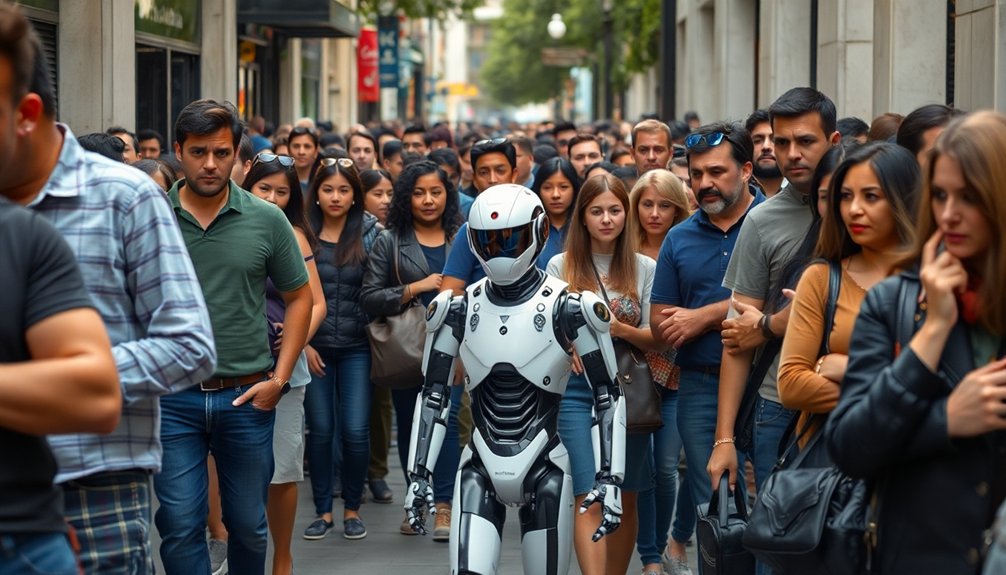
Despite humanity’s technological ambitions, robots aren’t just going to waltz into our lives without some serious pushback.
Technology’s grand visions will clash with human skepticism, creating a messy roadblock to robotic integration.
We’re talking major social friction points that’ll make tech adoption look like a messy breakup. Think about it: Who wants a robot potentially replacing human connection or harvesting personal data like some creepy digital stalker? Not most people, that’s who.
Our deep-seated fears aren’t just paranoia. Companion robots could create weird emotional dependencies, especially for vulnerable populations. Robotic deception strategies reveal how machines might manipulate human trust, further complicating these emotional boundaries.
Autonomous systems raise thorny ethical questions about decision-making accountability. Can we really trust machines with life-or-death choices?
And let’s not forget the looming job displacement threat that’ll make workers nervous about their future.
Operational Constraints in Real-World Deployment
So you’ve heard all about the social landmines of robot integration. Now let’s talk about the nitty-gritty: why robots often fail spectacularly in the real world. Turns out, creating a machine that can actually function outside a lab is harder than designing a rocket. Feedback loop challenges like sensor noise and external disturbances make robotic control systems unpredictable and prone to failure.
The real challenges? They’re everywhere:
- Sensors go haywire in unpredictable environments
- Power dies faster than your phone on vacation
- Communication breaks down like a teenager’s first relationship
- Hardware crumbles under real-world stress
Robots aren’t just fancy computers on wheels. They’re complex systems fighting against physics, entropy, and Murphy’s Law.
Navigation, power management, software reliability — each is a minefield waiting to blow up your million-dollar robot project. Welcome to the messy reality of autonomous machines.
Human-Robot Trust and Collaboration Dynamics
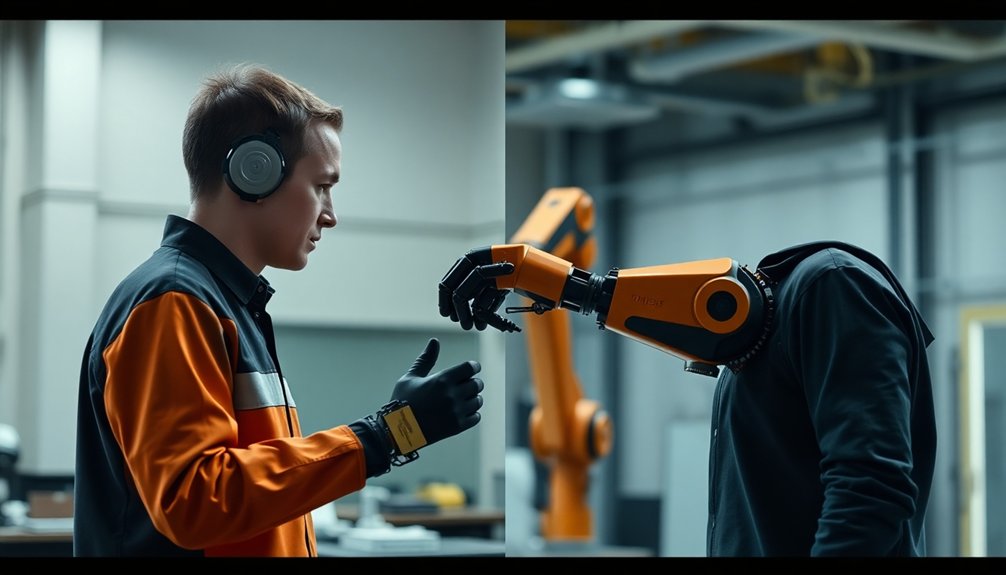
When humans and robots start dancing together in real workspaces, trust becomes the most delicate choreography you’ve never imagined. It’s like asking a stranger to be your dance partner while blindfolded—who moves first? Who trusts whom?
| Robot Action | Human Perception | Trust Level |
|---|---|---|
| Perfect Task | High Confidence | Rising ↑ |
| Minor Error | Slight Skepticism | Wavering → |
| Safety Breach | Immediate Doubt | Plummeting ↓ |
| Clear Communication | Reassured | Stabilizing = |
| Predictable Behavior | Comfortable | Increasing ↑ |
Your robotic colleague isn’t just a machine—it’s a potential partner with performance anxiety. Each interaction writes a new trust script, where one misstep can transform collaboration from smooth waltz to awkward stumble. Want real-world robot success? Learn to read the unspoken trust language between human and machine.
People Also Ask About Robots
Can Robots Learn From Unexpected Environmental Challenges in Real-Time?
You’ll need advanced machine learning algorithms and adaptive AI that can process sensor data rapidly, interpret unexpected challenges, and dynamically recalibrate strategies in real-time across complex environments.
How Do Robots Handle Emotional Human Reactions During Interactions?
You’re traversing an emotional minefield when robots decode human reactions. They’ll analyze facial cues, vocal patterns, and context, but struggle with nuanced, unpredictable emotional landscapes that defy algorithmic precision.
What Happens When Multiple Robots Need to Coordinate Simultaneously?
You’ll face coordination challenges as robots negotiate paths, manage communication delays, adapt to dynamic environments, and balance individual task efficiency with collective movement objectives.
Are Robot Decision-Making Algorithms Transparent Enough for Public Understanding?
You’ll find most robot decision-making algorithms aren’t transparent, hiding complex logic behind “black box” models that obscure critical reasoning processes from public understanding and scrutiny.
Can Low-Skilled Workers Retrain for Roles Supervising Robotic Systems?
You’re like a ship’s captain steering through uncharted waters: with targeted sector-based training and hands-on programs, you can shift from low-skilled work to supervising robotic systems effectively.
Why This Matters in Robotics
You’ve got robot dreams, but reality’s got other plans. Despite massive investments, robots keep tripping over their own algorithms. Why? Because the real world isn’t a controlled lab. It’s messy, unpredictable, and constantly changing. Your shiny robot friend might crush it in simulations, but ask it to navigate a cluttered kitchen? Good luck. The future of robotics isn’t about perfection—it’s about adaptability.
References
- https://mitsloan.mit.edu/ideas-made-to-matter/a-new-study-measures-actual-impact-robots-jobs-its-significant
- https://ojs.aaai.org/aimagazine/index.php/aimagazine/article/download/2651/2557
- https://www.stlouisfed.org/open-vault/2024/sep/are-robots-helpers-or-substitutes-for-workers
- https://kshitijtiwari.com/all-resources/mobile-robots/robot-deployment-challenges/
- https://www.sixthtone.com/news/1016947/humanoid-robots-are-poised-to-march-into-the-real-world
- https://www.oxfordeconomics.com/resource/ai-and-robots-in-2025-the-robotics-revolution-we-predicted-has-arrived/
- https://ifr.org/ifr-press-releases/news/top-5-global-robotics-trends-2025
- https://www.venasolutions.com/blog/automation-statistics
- https://flobotics.io/blog/rpa-statistics/
- https://www.globenewswire.com/news-release/2025/03/24/3047512/0/en/Industrial-Robotics-Market-to-Surge-from-USD-55-1-Billion-in-2025-to-USD-291-1-Billion-by-2035-Future-Market-Insights-Inc.html
